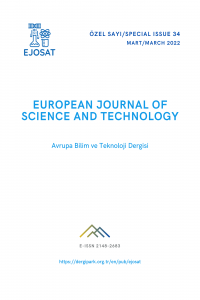Abstract
In this study, the mechanical and metallurgical properties of 304, 321 and 316Ti stainless steels used in tankers subject to the European agreement on the Carriage of Dangerous Goods by Road (ADR)[1] and the welding zones formed as a result of joining the mentioned materials with the ceramic-bottom welding method were evaluated. Tensile test was performed on welded and unwelded samples and their mechanical properties were compared. The microstructure of the weld zone and the heat-affected zone (HAZ) of the welded samples were examined by scanning electron microscopy (SEM) and row hardness was obtained using the Vickers hardness method, which is a microhardness method. Finally, the weld areas of the welded samples were examined by radiographic (x-ray) examination method. The tensile strength in non-welded materials was 669 MPa, with the highest in 304 steels. In welded samples, the highest tensile strength was observed as 643 MPA in the 304 steels. Additionally, in the tensile tests of the welded samples, the rupture occurred in the HAZ regions, not in the welded region.
Keywords
References
- (2022) The adrbook website. [online] Available: http://www. adrbook.com
- Aronsson B., On the origins and early growth of stainless steel: A survey with emphasis on the development in Sweden. Outokumpu Stainless research foundation, 2010.
- Aran, A., Temel, M.A. (2004). Paslanmaz çelikler.
- KIM 1.S., SON, J.S., KiM, I.G., KIM, J.Y., KIM, O.S., "A study on relationship between process variabln and bead penetration for robotic C02 arc welding ", 1. Materials Processing Technology, pp. 139-145, 136 (2003)
- ANIK, S., DİKİCİOGLU, A., VURAL, M., “ (1994) Koruyucu Gaz Altında Kaynak ve Alüminyum MIG Kaynağı”, Kaynak Tekniği Derneği Yayın No.: 1,
- Kım, I.S., SON, I.G., KIM, J.Y., KIM, O.S. (2003).A study on relationship between process variables and bead penetration for robotic CO2 arc welding. Journal of Material Processing Technology, 136, 139-145.
- Aıdun, D.K., Martin, S.A. (1997).Effect of sülfür and oxygen on weld penetration of high-purity austenitic stainless steels. Journal of Materials Engineering and Performance, 6, 496-502. ARABACI U., ÇİMEN M.Y, (2019) AISI 1050, 304 Ve 430 Tip Çeliklerin Yakma Alın Kaynak Yöntemiyle Kaynatılması ve Mekanik Özelliklerinin İncelenmesi.
- Tümer, M., Yılmaz, R. (2016). Characterization of microstructure, chemical composition, and toughness of multipass welded joint of austenitic stainless steel AISI316L. International Journal of Advanced Manufacturing Technology, 87, 2567-2579
- Kahraman H., GÜVENÇ M. A., MISTIKOĞLU S., (2021) AISI 304 Östenitik Paslanmaz Çelik Levhaların TIG Kaynağı ile Birleştirilmesinde Farklı Koruyucu Gaz Tiplerinin Mekanik Özelliklerine Etkisi.
ADR’li Tankerlerde Kullanılan Kaynaklı ve Kaynaksız Çeliklerin Mekanik Özelliklerinin Karşılaştırılması
Abstract
Bu çalışmada, Tehlikeli Maddelerin Karayolunda Taşınmasına ilişkin Avrupa Anlaşması (ADR)[1] tabii olan tankerlerde kullanılan 304, 321 ve 316Ti paslanmaz çelikler ve bahsedilen malzemelerin seramik altlı kaynak yöntemi ile birleştirilmesi sonucunda oluşan kaynak bölgelerinin mekanik ve metalürjik özellikleri değerlendirilmiştir. Kaynaklı ve kaynaksız numunelerden çekme testi yapılarak mekanik özellikleri karşılaştırılmıştır. Kaynaklı numunelerin kaynak bölgesi ve ısı tesiri altında kalan bölgenin (ITAB) mikro yapısı taramalı elektron mikroskobu (SEM) ile incelenmiş ve mikro sertlik yöntemi olan Vickers sertlik yöntemi ile sıra sertlikleri alınmıştır. Son olarak da kaynaklı numunelerin kaynak bölgeleri radyografik (röntgen) muayene yöntemi ile incelenmiştir. Kaynaksız malzemelerde çekme mukavameti 669 MPa ile en yüksek 304 çeliklerinde görülmüştür. Kaynaklı numunelerde ise en yüksek çekme mukavemeti 643 MPA ile 304 çeliklerinde görülmüştür. Ayrıca kaynaklı numunelerin çekme testlerinde kopma kaynağın olduğu bölgede değil ITAB bölgelerinde meydana gelmiştir.
Keywords
References
- (2022) The adrbook website. [online] Available: http://www. adrbook.com
- Aronsson B., On the origins and early growth of stainless steel: A survey with emphasis on the development in Sweden. Outokumpu Stainless research foundation, 2010.
- Aran, A., Temel, M.A. (2004). Paslanmaz çelikler.
- KIM 1.S., SON, J.S., KiM, I.G., KIM, J.Y., KIM, O.S., "A study on relationship between process variabln and bead penetration for robotic C02 arc welding ", 1. Materials Processing Technology, pp. 139-145, 136 (2003)
- ANIK, S., DİKİCİOGLU, A., VURAL, M., “ (1994) Koruyucu Gaz Altında Kaynak ve Alüminyum MIG Kaynağı”, Kaynak Tekniği Derneği Yayın No.: 1,
- Kım, I.S., SON, I.G., KIM, J.Y., KIM, O.S. (2003).A study on relationship between process variables and bead penetration for robotic CO2 arc welding. Journal of Material Processing Technology, 136, 139-145.
- Aıdun, D.K., Martin, S.A. (1997).Effect of sülfür and oxygen on weld penetration of high-purity austenitic stainless steels. Journal of Materials Engineering and Performance, 6, 496-502. ARABACI U., ÇİMEN M.Y, (2019) AISI 1050, 304 Ve 430 Tip Çeliklerin Yakma Alın Kaynak Yöntemiyle Kaynatılması ve Mekanik Özelliklerinin İncelenmesi.
- Tümer, M., Yılmaz, R. (2016). Characterization of microstructure, chemical composition, and toughness of multipass welded joint of austenitic stainless steel AISI316L. International Journal of Advanced Manufacturing Technology, 87, 2567-2579
- Kahraman H., GÜVENÇ M. A., MISTIKOĞLU S., (2021) AISI 304 Östenitik Paslanmaz Çelik Levhaların TIG Kaynağı ile Birleştirilmesinde Farklı Koruyucu Gaz Tiplerinin Mekanik Özelliklerine Etkisi.
Details
| Primary Language | English |
|---|---|
| Subjects | Engineering |
| Journal Section | Articles |
| Authors | |
| Early Pub Date | January 30, 2022 |
| Publication Date | March 31, 2022 |
| Published in Issue | Year 2022 Issue: 34 |


